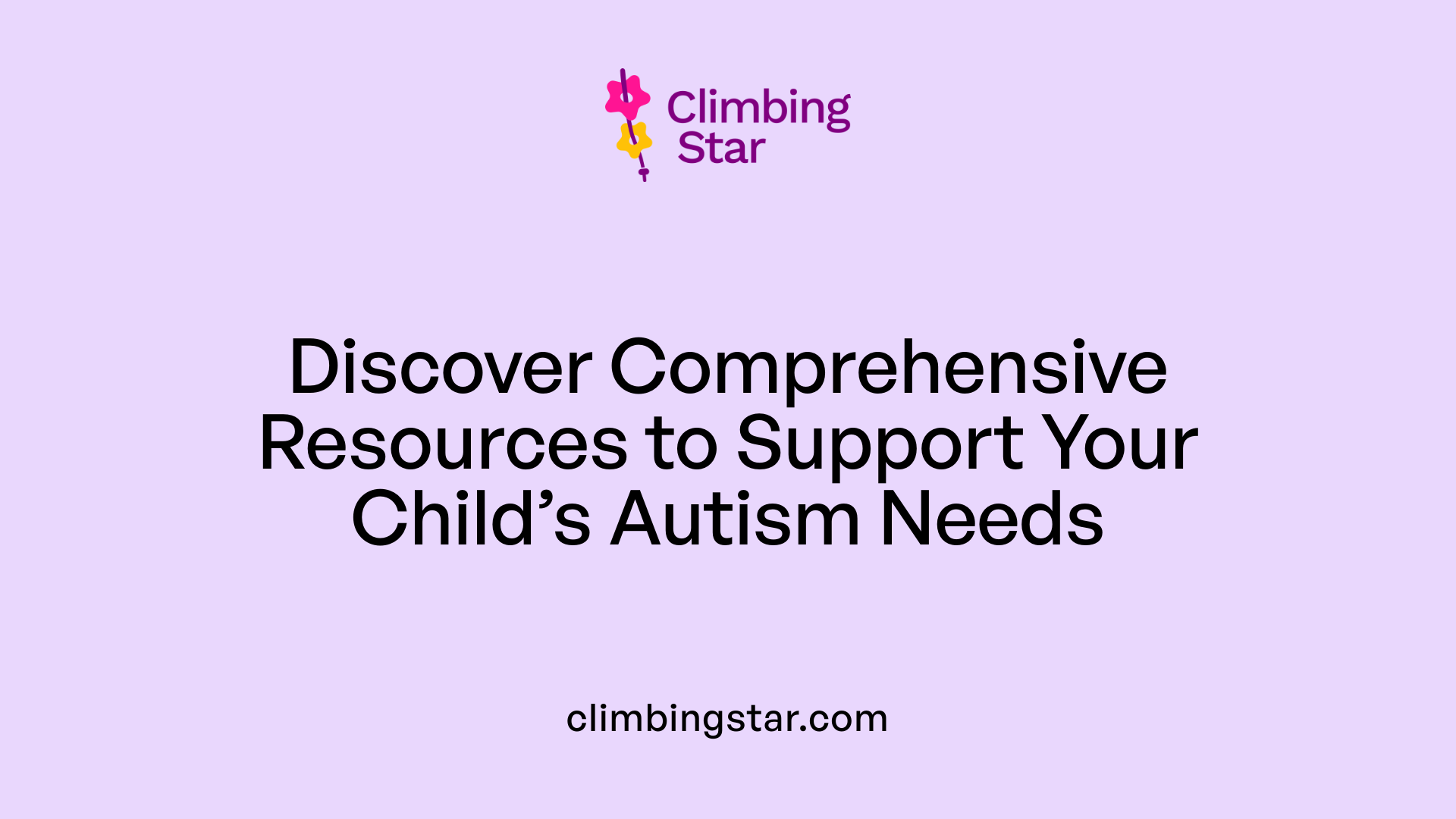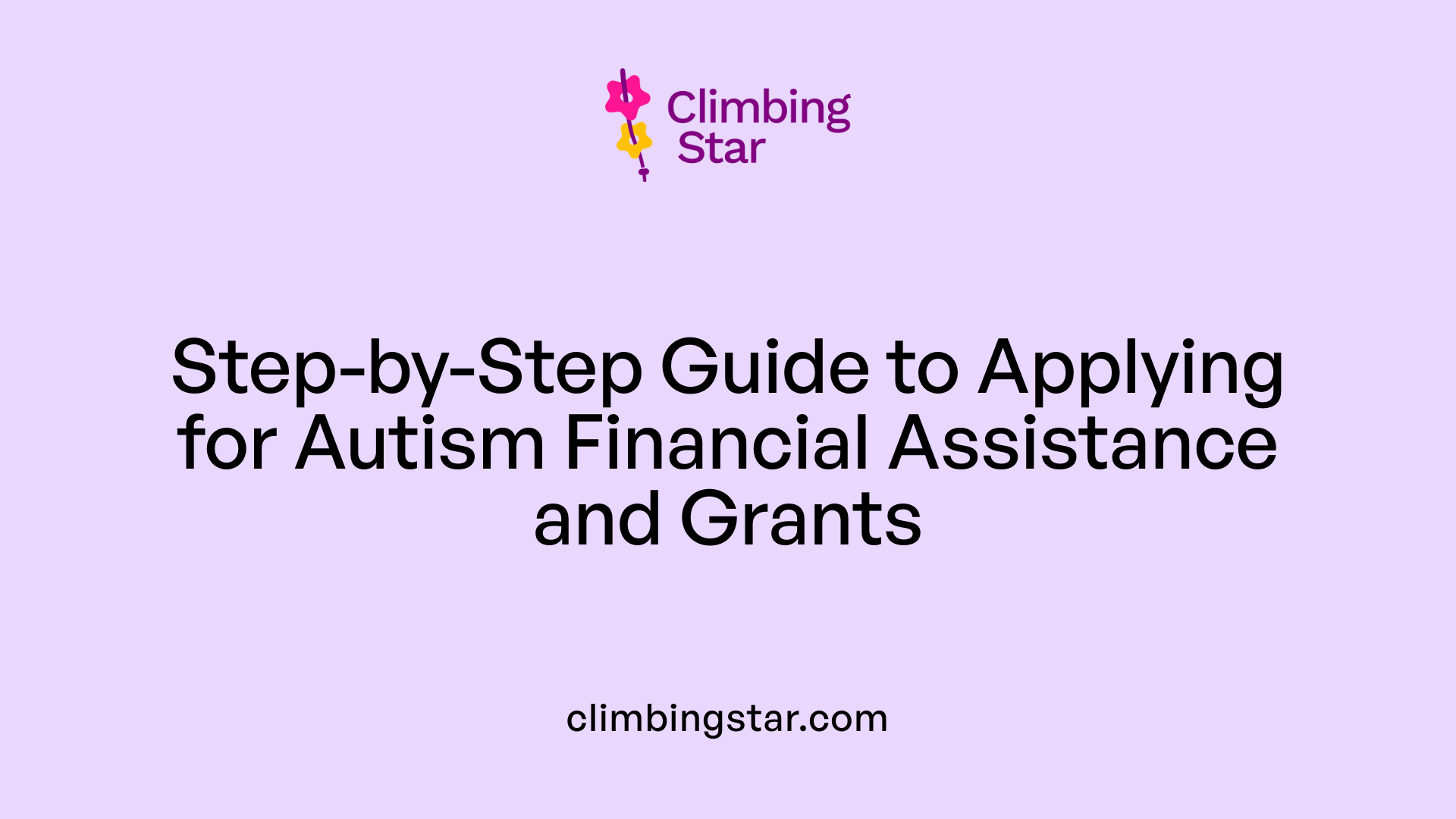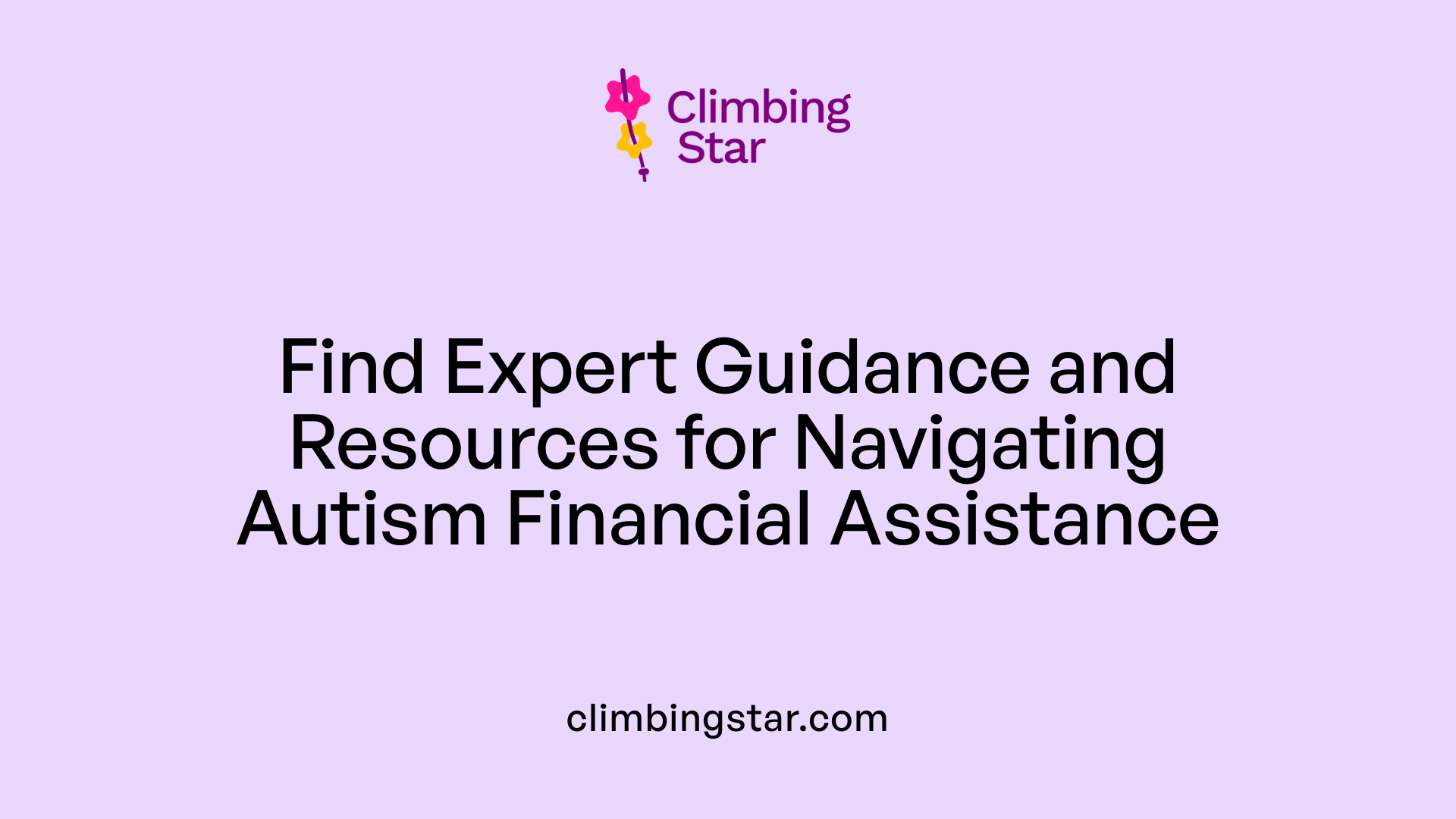Understanding Financial Resources for Autism Support
Families of individuals with autism face numerous financial challenges related to treatment, therapies, education, and daily care. Fortunately, a wide array of resources—spanning federal programs, private grants, and community services—are available to help alleviate some of these burdens. This article provides a comprehensive guide to the types of financial assistance accessible, how to access them, their eligibility criteria, and tips for applying effectively.
Main Support Options and Resources for Families

What are the main financial support options and resources available for individuals with autism and their families?
Families of children with autism face many challenges, especially regarding the costs of treatment, therapy, and daily care. Fortunately, there are numerous resources—federal, state, private, and community-based—that can help alleviate these financial burdens.
Federal Assistance Programs include several programs designed to provide direct financial aid and health coverage. The Supplemental Security Income (SSI) program offers monthly payments to children with disabilities who meet specific criteria and have limited household income. Most children approved for SSI also qualify for Medicaid, which covers medical expenses, therapies, and supportive services.
Social Security Disability Insurance (SSDI) is another federal benefit, mainly aimed at adults with disabilities, but it can indirectly support families by providing income assistance when the primary breadwinner is unable to work due to a disability. Additionally, programs like Medicaid Waivers enable families to access specialized services such as residential support, employment assistance, and behavioral therapy, based on individual needs.
Programs like the Children’s Health Insurance Program (CHIP) support children under 19 who do not qualify for Medicaid but still require affordable health coverage. The Temporary Assistance for Needy Families (TANF) offers cash aid and support services, including childcare and employment training, for low-income families. The Supplemental Nutrition Assistance Program (SNAP) helps families afford nutritious food, which is vital for children with special needs.
State-specific and Community Resources enhance federal offerings with additional options. Many states operate Medicaid Waivers, which provide tailored medical and support services based on the child’s disability level and family income. Local organizations like Community Action Agencies, housing assistance programs, and emergency aid organizations such as the Salvation Army offer additional financial help, housing support, and emergency funds.
Private Grants and Charitable Organizations represent a crucial support network. Autism Speaks compiles a comprehensive list of grants from various organizations that help families cover therapies, communication tools, safety equipment, and educational needs. Notable grant programs include Autism Care Today, Autism Spectrum Disorder Foundation, and the United Healthcare Children’s Foundation. Grants not only provide direct funding for therapy sessions like Applied Behavior Analysis (ABA), speech, and occupational therapy but also support the purchase of medical devices and communication aids, especially for non-verbal children.
Long-term Savings Tools such as ABLE accounts serve families by allowing them to save money for disability-related expenses without jeopardizing their eligibility for federal benefits. These accounts can be essential for covering costs that are not reimbursed by insurance or government programs.
Finally, Local community and emergency assistance are vital, especially during crises. Organizations like the Autism Society, Easterseals, and local parent groups offer information and access to temporary financial aid, respite care, counseling, and other essential services.
| Resource Type | Examples | Services Provided | Eligibility & Notes |
|---|---|---|---|
| Federal Benefits | SSI, SSDI, Medicaid, CHIP, TANF, SNAP | Monthly financial aid, healthcare, nutrition support | Income-based, specific disability criteria |
| State Programs | Medicaid Waivers, Community Aid | Customized therapies, residential support | Based on disability level and income |
| Private Grants | Autism Care Today, Ability Found, ASD Foundation | Therapy, equipment, scholarships | Application through local agencies or organizations |
| Savings Tools | ABLE Accounts | Long-term savings without benefit reduction | Open to individuals with disabilities |
| Community Aid | Salvation Army, Emergency Funds | Housing, crisis support | Varies by location and need |
This array of programs emphasizes a layered approach—families are encouraged to explore federal, state, and community options. Applying for these benefits often involves documentation such as proof of diagnosis, income statements, and medical records. Early application is recommended, as processing times can vary.
Locating appropriate services requires reaching out to local health and human services offices or advocacy organizations like Autism Speaks, Autism Society, and Easterseals. These groups can offer guidance on eligibility, assist with applications, and connect families with the resources they need to support their loved ones effectively.
By utilizing these diverse sources of financial support, families can better manage the costs associated with autism diagnosis and treatment, ensuring that children receive the necessary interventions and services to thrive.
Applying for Autism-Related Financial Support

How can individuals apply for financial aid, grants, and government funding for autism support?
Applying for financial assistance for autism-related needs involves several pathways, including government programs, private grants, and community resources. Families and individuals can start by exploring online portals dedicated to social services, such as the websites for the Social Security Administration (SSA), state health and human services departments, and nonprofit organizations like Autism Speaks and Autism Care Today.
For government programs like Supplemental Security Income (SSI) and Social Security Disability Insurance (SSDI), applicants typically need to complete detailed forms and provide supporting documentation. These documents include medical evaluations that describe the individual’s diagnosis, functional limitations, and the severity of symptoms. Income verification through W-2s, tax returns, or other financial statements is also required to determine eligibility.
Private grants from organizations such as The Orange Effect Foundation, Autism Speaks, and Autism Care Today generally require filling out application forms and submitting documentation that proves medical needs or financial hardship. Many of these organizations have application portals on their websites, making the process relatively accessible.
Local offices, including offices of state health and human services, play an essential role in guiding applicants through the process. Families can schedule appointments, seek assistance in completing forms, or get referrals for additional support services.
In some states, programs like the Medicaid Waivers or Home- and Community-Based Services (HCBS) also require applications, often handled through regional offices. These programs may need additional information such as a detailed care plan, assessments of daily functioning, and proof of income.
Tools such as ABLE accounts provide a way to save money tax-advantaged for disability-related expenses without risking eligibility for public benefits. Families interested in these should consult their state’s ABLE program website or plan provider.
For medical needs beyond basic coverage, families can apply for grants from foundations offering financial help for therapies, equipment, or communication devices. These grants often require submitting application forms along with proof of diagnosis, cost estimates for services or equipment, and sometimes letter of support from healthcare providers.
Step-by-step guidance for applying to SSI, SSDI, Medicaid Waivers, and grants
| Stage | Action | Details | Resources |
|---|---|---|---|
| 1 | Gather Documentation | Collect medical evaluations, proof of income, and identification | Healthcare providers, tax documents |
| 2 | Complete Application | Fill out online forms or paper applications via SSA, state agencies, or nonprofit portals | SSA website, state health department sites |
| 3 | Submit Supporting Materials | Attach medical reports, financial proofs, and treatment plans | Online portals, mail, or in-person offices |
| 4 | Follow Up | Track application status and provide additional information if requested | SSA caseworker contacts, online case trackers |
| 5 | Receive Decisions | Get official approval letter and benefit details | SSA, Medicaid office |
| 6 | Appeal or Reapply | If denied, appeal decision or reapply with additional supporting evidence | SSA appeals process, advocacy groups |
Utilizing online portals, local offices, and advocacy groups
Most application processes are designed to be user-friendly via online portals. These platforms often allow you to create an account, upload documents, and track application progress. Examples include the SSA’s online Application Portal for SSI and SSDI, or the state Medicaid agency’s website for waiver programs.
Local offices are invaluable for personalized assistance. Families can visit local social service offices for in-person help, attend information sessions, or request case management support. Advocacy groups like Autism Speaks, Easterseals, or local parent organizations often run workshops and can provide guidance on completing applications.
Final tips
- Start early: Some programs can take months to process.
- Keep duplicates: Maintain copies of all application materials.
- Seek assistance: Reach out to local support groups or legal advocates if needed.
By understanding the detailed steps and available resources, families can better navigate the process of obtaining essential financial support for autism-related needs, easing their financial burden and helping provide essential care.
Eligibility Criteria for Autism Benefits and Assistance
What are the eligibility criteria and qualifications required to receive autism-related benefits and government assistance programs?
Determining eligibility for autism-related financial aid depends on specific qualifications set by each program. The process generally involves a combination of medical documentation, assessment of functional impairment, and income verification.
Most government and nonprofit programs require a confirmed diagnosis of autism from a qualified healthcare provider. This diagnosis must be supported by medical records that detail the child's condition, including deficits in social interaction, communication, and repetitive behaviors, as outlined in the SSA’s Blue Book.
In addition to diagnosis, assessing the severity of autism is crucial. Many programs, such as SSI, require evidence of significant functional impairment, especially in areas like understanding information, interacting with others, focusing on activities, and self-management. These assessments help determine if the child's condition substantially limits daily activities.
Financial eligibility is another important factor. Programs like SSI and Medicaid impose income and resource limits. Applicants must provide documentation such as W-2 forms, tax returns, or bank statements to verify their financial situation. If the household income exceeds the threshold, families might not qualify but still should consult local programs for alternatives.
Program-specific eligibility criteria also vary based on age and the nature of the services needed. For example, Medicaid Waivers often cater to children under age 21, while some scholarships are designated for school-age children with demonstrated financial need.
Many states have additional criteria for their Autism Waivers or community-based services, which might include the severity of disability, the level of support required, and living arrangements.
Overall, applicants should prepare comprehensive medical documentation and thoroughly review the specific eligibility requirements of each program. Consulting resources like the SSA’s Child Disability Starter Kit can help families gather necessary information and streamline their application process.
| Program Type | Qualification Requirements | Additional Notes |
|---|---|---|
| SSI (Supplemental Security Income) | Diagnosis of autism, significant functional impairment, limited income/resources | Supports children with disabilities, eligibility varies by household income |
| Medicaid and Waivers | Diagnosis, age (often under 21), severity of impairment, income limits | Offers services like therapy, behavioral support, and residential care |
| CHIP (Children’s Health Insurance Program) | Low-income, age under 19, autism diagnosis | Provides health coverage mainly for medical treatments |
| Autism Grants and Scholarships | Confirmation of diagnosis, proof of need, age-specific criteria | Focused on treatment costs, equipment, and educational supports |
Prospective applicants should verify eligibility with their local health and human services offices or trusted organizations such as Autism Speaks, Autism Society, or Easterseals. Collecting accurate documentation and understanding specific program criteria enhances the chances of securing needed support.
Types of Financial Assistance for Children with Autism

What types of financial assistance are available for children with autism, such as SSI and IHSS?
Families with children diagnosed with autism have access to a variety of financial aid programs at the federal, state, and private levels. These resources are designed to help manage the cost of treatments, therapies, equipment, and ongoing care.
At the federal level, Supplemental Security Income (SSI) is a crucial benefit. It provides monthly financial payments to children with disabilities, including autism, based on income eligibility. Most children on SSI also qualify for Medicaid, which covers much of their health care needs, including therapies, medications, and sometimes residential services.
Similarly, Social Security Disability Insurance (SSDI) supports adults with autism whose condition began early in life. For children, the focus is mainly on SSI, but SSDI can be applicable if the individual later becomes disabled as an adult.
State programs expand these options further. For instance, California's In-Home Supportive Services (IHSS) program offers in-home care, personal assistance, and domestic support services. The eligibility depends on health needs, income level, and age, with the program providing hours of care that vary based on individual assessments. For example, children who need help with daily activities or behavioral support can receive tailored care hours, which can significantly ease family caregiving burdens.
Additionally, Medicaid Waivers, such as the Home- and Community-Based Services (HCBS) programs, provide funding for services like therapy, respite care, and medical treatments. Eligibility often depends on the level of disability and family income, making these resources accessible to many families seeking comprehensive care support.
Private foundations and nonprofit organizations also play a vital role. Many offer grants, scholarships, and funding specifically for therapies, communication devices, and adaptive equipment. These funds often target urgent needs, underserved populations, or specific services such as Applied Behavior Analysis (ABA), speech therapy, or specialized communication aids.
In summary, families are encouraged to explore a broad spectrum of available supports. Federal programs like SSI and Medicaid are central, complemented by state-specific services like IHSS and state waivers. Private foundations enhance these options by providing targeted grants to cover therapies, equipment, and emergency needs.
To locate these resources, families can contact local health and human services agencies, advocacy organizations such as Autism Speaks, and state-specific program offices. Early application is recommended to ensure services and financial assistance are in place when needed the most.
Utilizing and Accessing Financial Resources Effectively
How can families access and utilize available financial resources for autism assistance?
Families seeking financial support for autism can tap into a variety of resources at federal, state, and community levels. Beginning with the federal programs, families should explore options like Supplemental Security Income (SSI), which provides monthly payments to children with disabilities who meet specific criteria such as deficits in social interaction, communication, and repetitive behaviors. Most children on SSI also qualify for Medicaid, covering essential health care needs.
In addition to SSI, programs like Social Security Disability Insurance (SSDI) and Medicaid Waivers offer care support services and financial assistance. Medicaid Waivers can fund various therapies, including Applied Behavior Analysis (ABA), speech, and occupational therapy, tailored to individual needs. For families with higher long-term savings goals, ABLE accounts are a strategic option. These savings accounts allow families to save without risking eligibility for public benefits, thus providing a flexible financial planning tool.
The Children’s Health Insurance Program (CHIP) caters to children who do not qualify for Medicaid but still require affordable health coverage. The Temporary Assistance for Needy Families (TANF) program provides not just financial aid but also services like childcare support and job preparation, helping create a broader safety net.
Community resources are equally vital. Agencies such as Community Action Agencies and local organizations like the Salvation Army provide emergency assistance, housing aid, and food support. The nationwide 2-1-1 help line can connect families to immediate community aid and resources tailored to their location.
For immediate and ongoing needs, families should also look into autism-specific grants and funding from national organizations. Autism Speaks, for example, maintains a comprehensive list of grants available for treatments, communication devices, safety equipment, and therapy services. These grants range from equipment like augmentative communication devices to scholarships supporting educational and behavioral therapies.
Engaging with local autism support groups, advocacy organizations like the Autism Society, and insurance resource centers can help families navigate complex coverage options and identify additional funding opportunities. Additionally, consulting legal tools and resources can assist in understanding eligibility criteria for these programs and in preparing necessary documentation.
In practice, the process involves:
- Reaching out to state or county health and human services offices.
- Consulting with autism support groups and nonprofits.
- Carefully reviewing program eligibility and preparing documentation, including medical records and income verification.
- Applying promptly to avoid delays, especially for time-sensitive grants.
By staying informed and proactive, families can better utilize available resources and build a comprehensive support network tailored to their child's needs.
Resources overview:
| Resource Type | Program/Organization | Support Offered | Notes |
|---|---|---|---|
| Federal | SSI, SSDI, Medicaid Waivers | Financial aid, health care support | Need medical documentation for eligibility |
| State | CHIP, IHSS, State-specific grants | Health coverage, personal care support | Check local offices for application procedures |
| Community | 2-1-1, Salvation Army, local agencies | Emergency aid, food, housing | Contact local organizations for immediate needs |
| Nonprofit Organizations | Autism Speaks, Autism Society, Autism Care Today | Grants, therapy funding, equipment | Many do not administer grants but provide valuable information |
Final Tips
- Keep detailed records of medical diagnoses, income, and expenses.
- Act quickly on grant applications or benefit claims.
- Utilize online resources for updated forms, eligibility guides, and contact information.
- Participate in support groups for shared experiences and advice.
In summary, leveraging a mix of federal programs, community services, and nonprofit grants can help families manage the financial challenges of raising a child with autism. Staying informed and connected is essential to accessing and maximizing these opportunities.
Support and Guidance for Autism-Related Financial Help

Where can I find resources and guidance on applying for autism-related financial aid and benefits?
Navigating the landscape of financial aid and support for autism can seem overwhelming, but numerous resources are available to assist families. National organizations like Autism Speaks serve as valuable starting points. They compile comprehensive lists of programs such as Supplemental Security Income (SSI), Social Security Disability Insurance (SSDI), Medicaid Waivers, and ABLE accounts. These resources include detailed tips on how to apply, eligibility requirements, and necessary documentation.
In addition to Autism Speaks, there are numerous advocacy and support organizations at the community and state levels, including the Autism Society, Easterseals, and local agencies. These groups offer guidance, application assistance, and sometimes direct support. They can help families understand federal laws like the Individuals with Disabilities Education Act (IDEA) and Medicaid, as well as state-specific programs, such as Home- and Community-Based Services (HCBS) waivers.
Federal programs like SSI provide monthly payments to families raising children with disabilities, with most children also qualifying for Medicaid, which covers health care and related services. State and local agencies often administer additional supports, like housing assistance, emergency aid, and specialized therapies.
For personalized guidance, families are encouraged to contact local health and human services offices or community organizations. These entities can offer step-by-step assistance in preparing necessary documentation, understanding eligibility criteria, and completing application procedures.
What steps should I take to ensure a successful application for autism-related financial programs?
First, gather detailed medical documentation confirming the autism diagnosis and its impact on daily functioning. This includes reports from healthcare providers, behavioral assessments, and evidence of functional limitations.
Next, compile financial documents such as recent tax returns, W-2 forms, and household income statements to demonstrate financial eligibility.
To streamline the process, review available resources like the SSA’s Child Disability Starter Kit, which offers guidance on preparing for a disability application.
Then, submit the application through the appropriate channels—either online via government portals, by mail, or in person at local agencies. Prompt application is important due to processing times.
Follow up regularly on the application status, and be prepared to supply additional documentation or clarification if requested.
Finally, leverage community outreach programs and advocacy organizations for support during the application process. Many of these groups provide workshops, free consultations, and direct assistance.
Additional Resources and Information
| Resource Type | Description | Contact/Website | Notes |
|---|---|---|---|
| Autism Speaks | Program guides and funding resources | www.autismspeaks.org | Comprehensive list of resources and tips |
| Social Security Administration | Disability benefits application | www.ssa.gov | Blue Book criteria detailed |
| State Medicaid Office | State-specific Medicaid waivers | State.gov | Check for HCBS programs |
| Local Autism Societies | Community support and guidance | Local directories | Personal assistance and group support |
| Easterseals | Family support services | www.easterseals.com | Grants, trainings, and advocacy |
Understanding and applying for autism-related financial aid requires patience and organization. Utilizing these resources can significantly improve the chances of securing the support needed to assist children with autism and their families.
Empowering Families with Knowledge and Resources
Navigating the financial landscape for autism support can be complex, but with a clear understanding of available resources and proper guidance, families can access essential funding to improve quality of life for their loved ones. By leveraging federal, state, private, and community programs, and seeking support from advocacy organizations, families can better plan for and manage the considerable expenses associated with autism. Staying informed and prepared matching the specific needs of each individual with autism is key—there are options out there, and help is within reach.







